Abstract
The ability of hard-shelled clams (Mercenaria mercenaria) to accumulate fecal coliforms and other microorganisms (Escherichia coli, Clostridium perfringens, and male-specific bacteriophages) was determined over a 1-year period. Twenty separate trails were conducted during different seasons to encompass a wide range of water temperatures. The greatest accumulation of microorganisms in hard-shelled clams occurred during certain periods in the spring, at temperatures ranging from 11.5 to 21.5 degrees C. These periods of hyperaccumulation did not always coincide for all organisms; the accumulation of bacteriophages was not predicted by the accumulation of either fecal coliforms or C. perfringens. Bacteriophages and C. perfringens showed significantly higher rates of accumulation than either the fecal coliform group or E. coli, especially during the spring. The higher incidence of human viral gastroenteritis associated with the consumption of shellfish during this period may be a result of the extraordinary concentration of certain microorganisms, including enteric viral pathogens.
Full text
PDF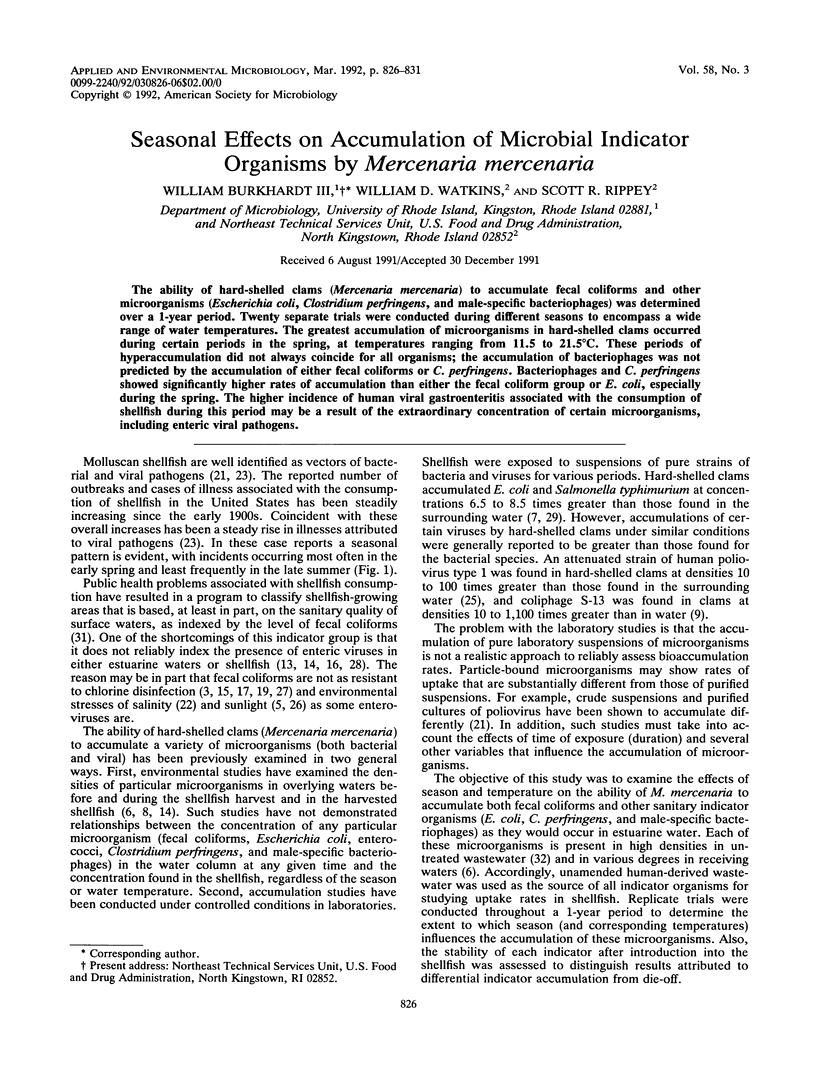
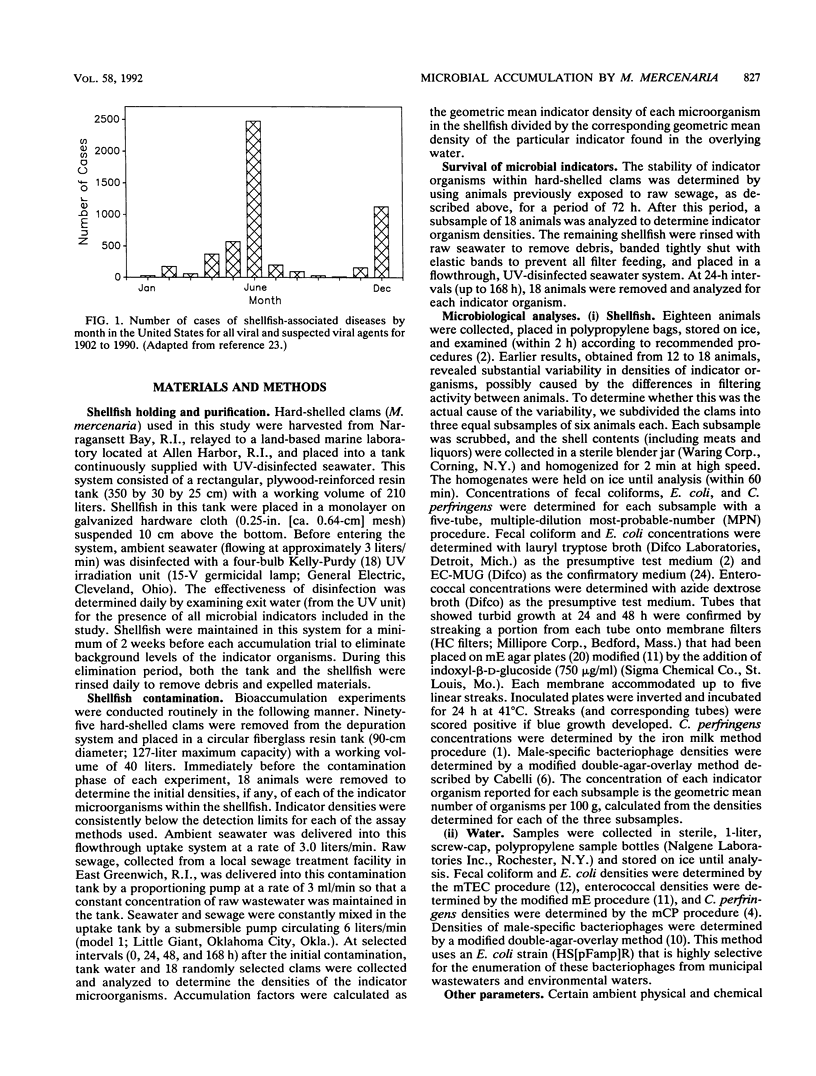
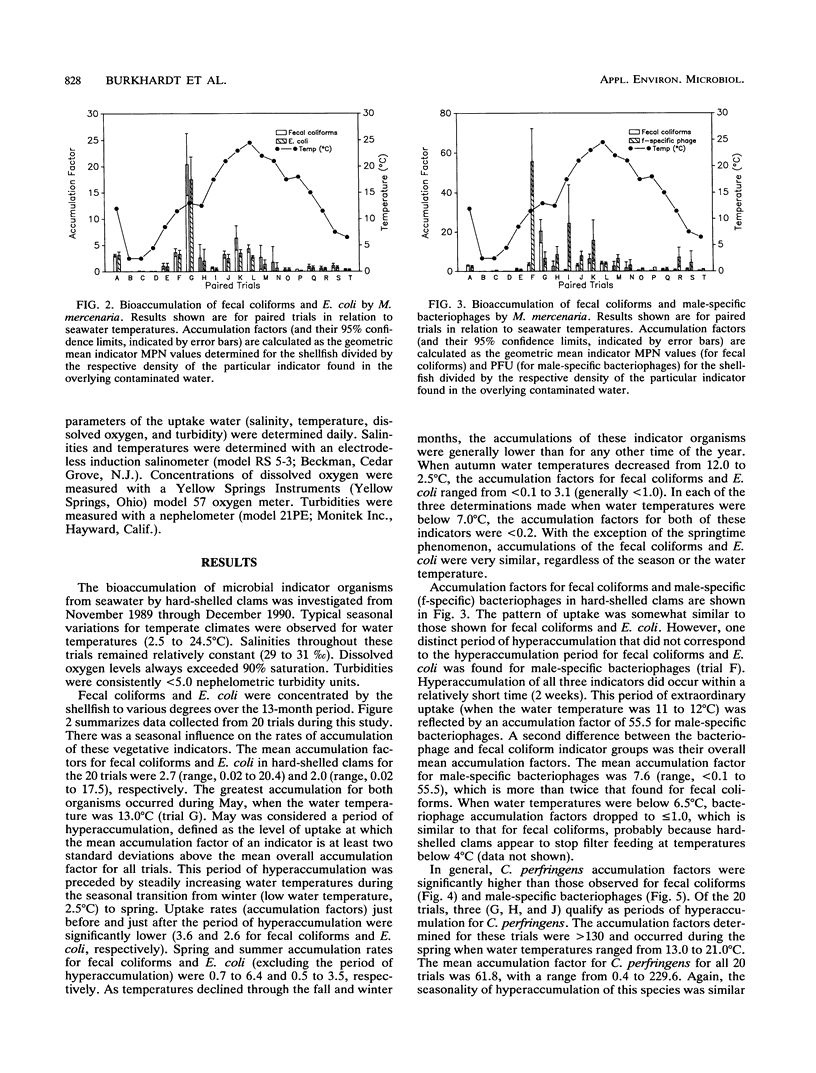
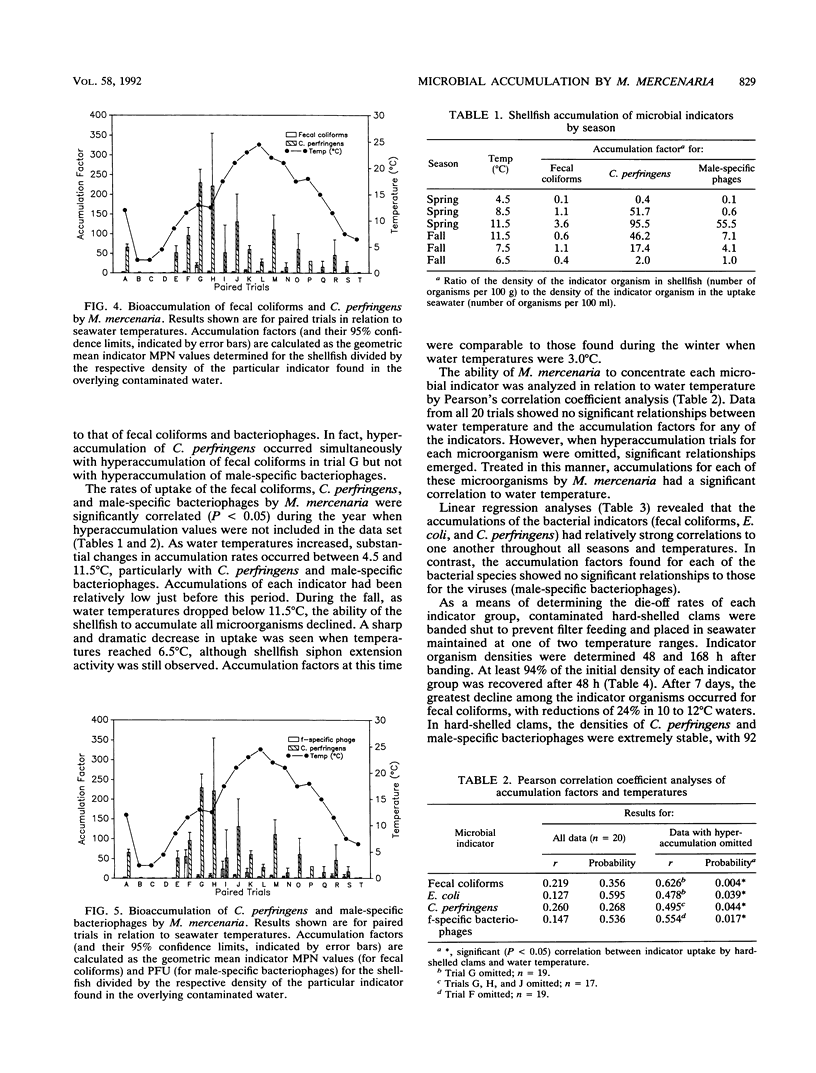
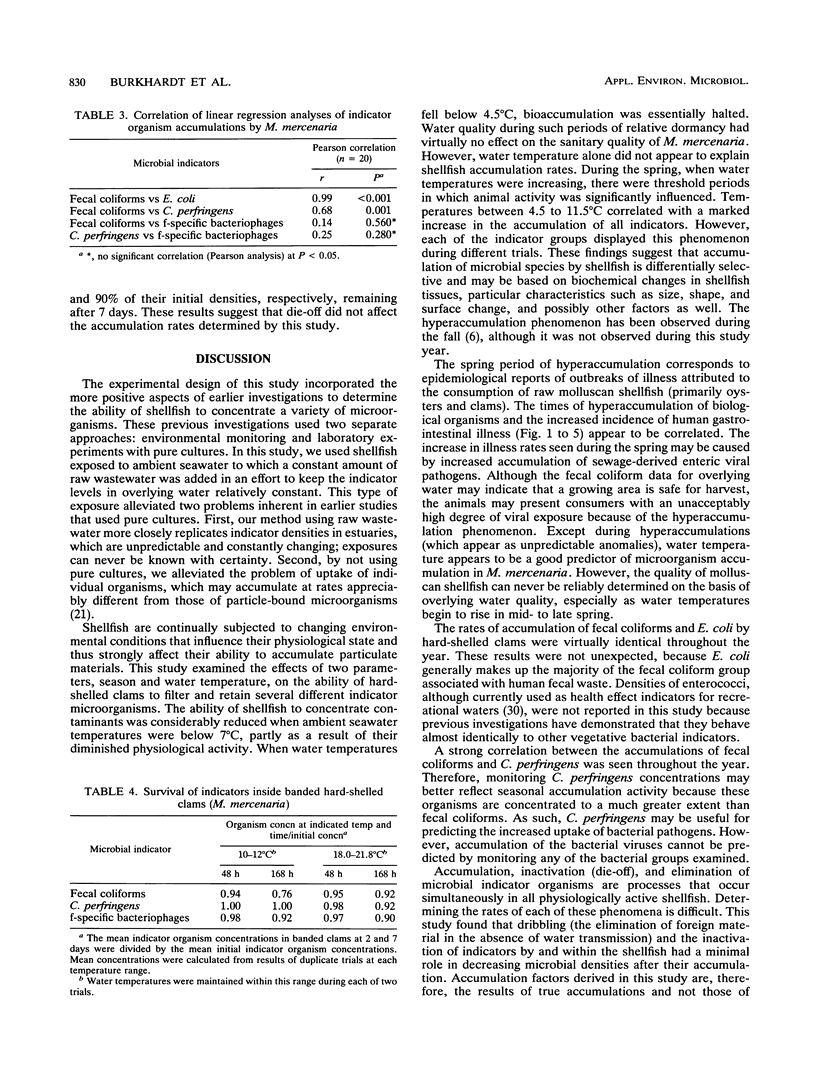
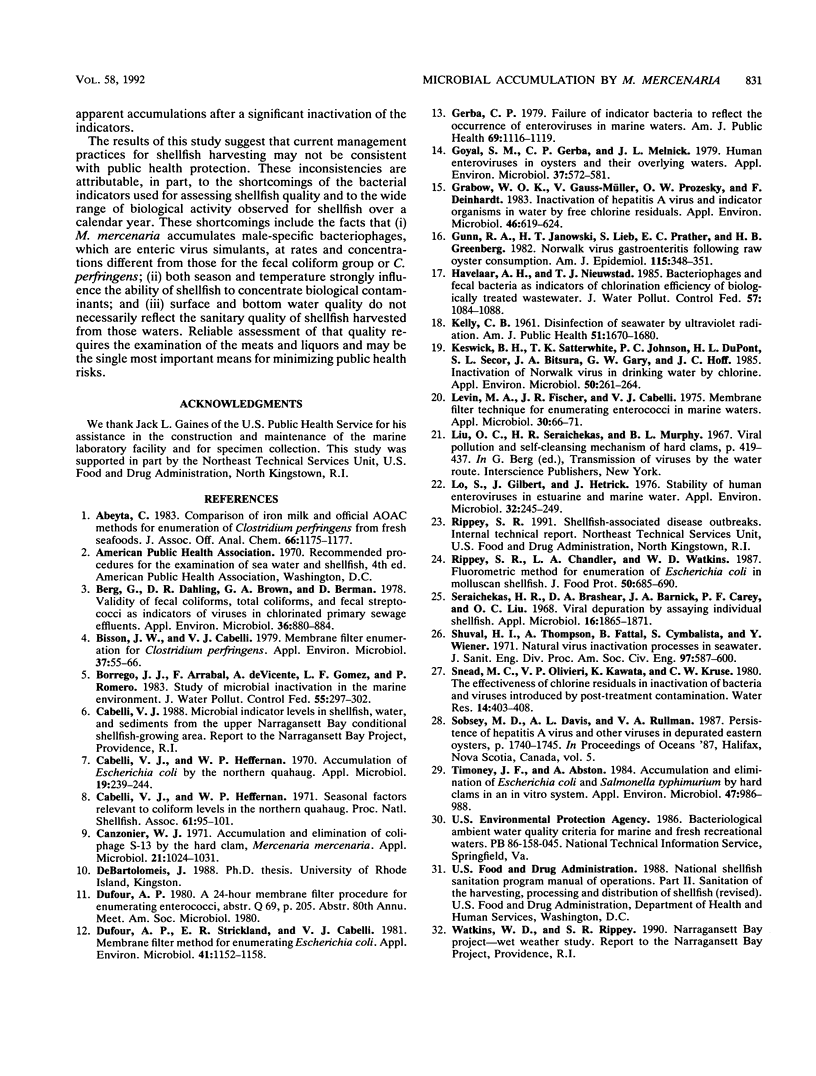
Selected References
These references are in PubMed. This may not be the complete list of references from this article.
- Abeyta C., Jr Comparison of iron milk and official AOAC methods for enumeration of Clostridium perfringens from fresh seafoods. J Assoc Off Anal Chem. 1983 Sep;66(5):1175–1177. [PubMed] [Google Scholar]
- Berg G., Dahling D. R., Brown G. A., Berman D. Validity of fecal coliforms, total coliforms, and fecal streptococci as indicators of viruses in chlorinated primary sewage effluents. Appl Environ Microbiol. 1978 Dec;36(6):880–884. doi: 10.1128/aem.36.6.880-884.1978. [DOI] [PMC free article] [PubMed] [Google Scholar]
- Bisson J. W., Cabelli V. J. Membrane filter enumeration method for Clostridium perfringens. Appl Environ Microbiol. 1979 Jan;37(1):55–66. doi: 10.1128/aem.37.1.55-66.1979. [DOI] [PMC free article] [PubMed] [Google Scholar]
- Cabelli V. J., Heffernan W. P. Accumulation of Escherichia coli by the Northern quahaug. Appl Microbiol. 1970 Feb;19(2):239–244. doi: 10.1128/am.19.2.239-244.1970. [DOI] [PMC free article] [PubMed] [Google Scholar]
- Canzonier W. J. Accumulation and elimination of coliphage S-13 by the hard clam, Mercenaria mercenaria. Appl Microbiol. 1971 Jun;21(6):1024–1031. doi: 10.1128/am.21.6.1024-1031.1971. [DOI] [PMC free article] [PubMed] [Google Scholar]
- Dufour A. P., Strickland E. R., Cabelli V. J. Membrane filter method for enumerating Escherichia coli. Appl Environ Microbiol. 1981 May;41(5):1152–1158. doi: 10.1128/aem.41.5.1152-1158.1981. [DOI] [PMC free article] [PubMed] [Google Scholar]
- Gerba C. P., Goyal S. M., LaBelle R. L., Cech I., Bodgan G. F. Failure of indicator bacteria to reflect the occurrence of enteroviruses in marine waters. Am J Public Health. 1979 Nov;69(11):1116–1119. doi: 10.2105/ajph.69.11.1116. [DOI] [PMC free article] [PubMed] [Google Scholar]
- Goyal S. M., Gerba C. P., Melnick J. L. Human enteroviruses in oysters and their overlying waters. Appl Environ Microbiol. 1979 Mar;37(3):572–581. doi: 10.1128/aem.37.3.572-581.1979. [DOI] [PMC free article] [PubMed] [Google Scholar]
- Grabow W. O., Gauss-Müller V., Prozesky O. W., Deinhardt F. Inactivation of hepatitis A virus and indicator organisms in water by free chlorine residuals. Appl Environ Microbiol. 1983 Sep;46(3):619–624. doi: 10.1128/aem.46.3.619-624.1983. [DOI] [PMC free article] [PubMed] [Google Scholar]
- Gunn R. A., Janowski H. T., Lieb S., Prather E. C., Greenberg H. B. Norwalk virus gastroenteritis following raw oyster consumption. Am J Epidemiol. 1982 Mar;115(3):348–351. doi: 10.1093/oxfordjournals.aje.a113311. [DOI] [PubMed] [Google Scholar]
- KELLY C. B. Disinfection of sea water by ultraviolet radiation. Am J Public Health Nations Health. 1961 Nov;51:1670–1680. doi: 10.2105/ajph.51.11.1670. [DOI] [PMC free article] [PubMed] [Google Scholar]
- Keswick B. H., Satterwhite T. K., Johnson P. C., DuPont H. L., Secor S. L., Bitsura J. A., Gary G. W., Hoff J. C. Inactivation of Norwalk virus in drinking water by chlorine. Appl Environ Microbiol. 1985 Aug;50(2):261–264. doi: 10.1128/aem.50.2.261-264.1985. [DOI] [PMC free article] [PubMed] [Google Scholar]
- Levin M. A., Fischer J. R., Cabelli V. J. Membrane filter technique for enumeration of enterococci in marine waters. Appl Microbiol. 1975 Jul;30(1):66–71. doi: 10.1128/am.30.1.66-71.1975. [DOI] [PMC free article] [PubMed] [Google Scholar]
- Lo S., Gilbert J., Hetrick F. Stability of human enteroviruses in estuarine and marine waters. Appl Environ Microbiol. 1976 Aug;32(2):245–249. doi: 10.1128/aem.32.2.245-249.1976. [DOI] [PMC free article] [PubMed] [Google Scholar]
- Seraichekas H. R., Brashear D. A., Barnick J. A., Carey P. F., Liu O. C. Viral depuration by assaying individual shellfish. Appl Microbiol. 1968 Dec;16(12):1865–1871. doi: 10.1128/am.16.12.1865-1871.1968. [DOI] [PMC free article] [PubMed] [Google Scholar]
- Timoney J. F., Abston A. Accumulation and elimination of Escherichia coli and Salmonella typhimurium by hard clams in an in vitro system. Appl Environ Microbiol. 1984 May;47(5):986–988. doi: 10.1128/aem.47.5.986-988.1984. [DOI] [PMC free article] [PubMed] [Google Scholar]


